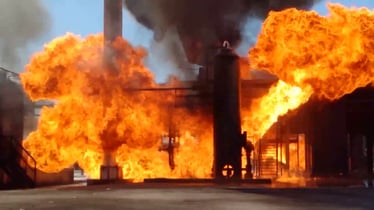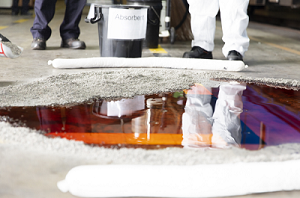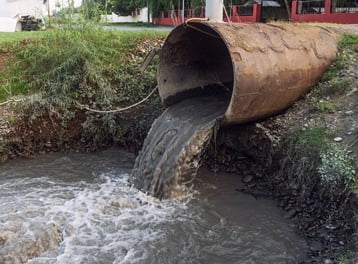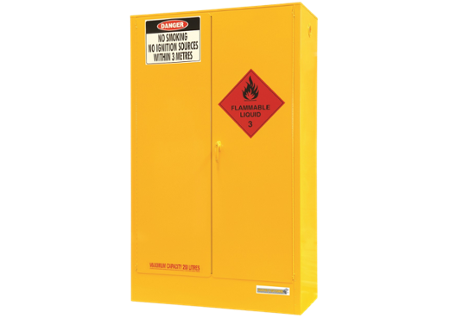What is the first thing that comes to mind when you hear the words ‘chemical spill’? Is it a massive oil slick polluting a pristine coastline, suffocating ocean birds and killing marine animals? I’m sure many of us would think of a situation just like that. But, have you considered that a chemical spill can be something as common as an employee spilling petrol over a workshop floor or a staff member tipping over a can of paint?
Even small quantities of commonly found flammable and combustible liquids – such as petrol, paint, oil or thinners – can cause major problems for organisations if the chemicals leaks or spills. From fires and explosions to injuries and environmental damage, flammable and combustible liquids can cause serious hazards in your workplace if they’re not stored, maintained and handled in the correct way.
Regardless of whether your business is carrying 10,000 litres of flammable liquids or just a few, you have a legal obligation to contain and manage chemical spills and leaks. In this blog, we’ll explain how you can fulfill your legal obligations with compliant spill bunding.
Flammable Liquids and Spill Hazards
Every Australian business that carries any type of hazardous chemical has an obligation to have a spill containment system in place. This system should effectively manage leaks or spills including the resulting effluent.
Failure to comply can result in fines of up to $30,000 for each offence.
But apart from your legal obligations in managing chemical leaks and spills, storing and handling flammable liquids in the workplace can create a series of complex hazards. If you have the correct spill containment systems and bunding products in place, your organisation can prevent serious hazards such as chemical exposure injuries, fires, explosions and environmental damage.
Incidences of Flammable Liquid Fires
Because flammable and combustible liquids are so common in worksites all over the country, there are many incidences of fires or explosions due to the mishandling and incorrect storage of these hazardous substances.
In 2018, the Western Australia Department of Mines, Industry Regulation and Safety (DMIRS), investigated an incident involving a fire in a WA mechanical workshop. The fire started when an ignition source was introduced close to an open tray of flammable solvent. The fumes from the solvent quickly ignited and caused serious burn injuries to a worker as well as destroying the building.

Flammable liquid fires can cause severe damage to people, property and the environment
Another incident recently occurred at a distillery in Tasmania. ABC News reported that a man was in a critical condition after flammable liquids in the distillery ignited. The building also caught fire with damaged estimated at between $1.5 and $2 million.
What are The Specific Hazards?
Now that we understand the significance of properly containing your flammable and combustible liquids, let’s look more closely at the types of hazards that they can produce in the workplace:
1. Fires and Explosions
Did you know that flammable liquids produce vapours that are heavier than the air that surrounds us? Once a container of chemicals is opened — or it spills on the ground — these flammable vapours escape and create a vapour trail.
Worryingly, chemical vapours are capable of igniting 100 metres from the source. And in a confined space they can become explosive. explosive?
Spilled chemicals can soak into the ground — as well as wooden pallets, brooms, rags and clothing — and remain flammable for a long time.
But even worse, flammable liquids that have ignited can travel down stairways, under doorways, and around corners —giving the fire an enormous reach.

Spilled chemicals can come in contact with ignition sources and cause fires and explosions
2. Chemical Exposure
The risk to human health from a flammable liquid spill can result in acute or chronic health issues. Many flammable liquids are harmful to human health if inhaled, ingested, swallowed, or splashed on the eyes and skin.
Site personnel can be harmed during the spill clean-up process. Workers or contractors who enter an area with no spill containment system may also be exposed to unsafe chemical concentrations — without even realising they are in danger. Therefore, chemical spills and leaks, while they may be common, can cause severe damage to your people as well as your property.
3. Environmental Damage
You may not be aware, but flammable and combustible liquids are often corrosive and toxic to the natural environment. These substances can cause serious environmental issues if they enter drains and waterways. In fact, some flammable solvents are so toxic they can permanently contaminate groundwater just by soaking into the soil.
Spill containment acts as an impermeable barrier to prevent chemical spills from spreading through worksites — and damaging the surrounding environment.
REMEMBER: Australian businesses who use and store hazardous chemicals also have responsibilities under the Environmental Protection Agency in their home state or territory.

Flammable and combustible liquids can be corrosive and toxic to the environment
Compliant Bunding For Flammable Liquids
To ensure your chemical storage and handling areas are fully compliant with WHS Legislation and Australian Safety Standards spill bunding must be:
- Impervious — ie, sturdy enough to hold the chemicals, and well-constructed so chemicals will not leak at the seams or drain plugs.
- Chemically resistant — ie, made (or finished) from materials that will not react with the chemicals and produce rust or corrosion.
- Fire resistant — ie, made from steel or other non-combustible material.
- Capable of recovering chemicals — ie, use a drain plug or have removable grates so spilled chemicals can be removed and disposed of safely.
“Provision shall be made to contain any leaks or spillages, and to prevent them from contaminating the surrounding soil or entering any watercourse or water drainage system.” Section 4.4.3 Australian Standard AS1940:2017.
Spill Bunding Around The Job Site
Most job sites need a mix of permanent and temporary spill containment systems to properly address their workplace risks and hazards. To achieve a safe and compliant workplace, you can choose spill bunding such as:
- Dedicated indoor storage cabinets that provide liquid tight spill containment
- Outdoor chemical stores that have compliant spill containment
- Closed decanting systems and lube stations that have inbuilt spill protection
- Relocatable spill bunding for temporary storage
Because flammable and combustible liquids pose a risk of fire and explosion, we highly recommend using spill bunds made from heavy duty steel in each of the following work areas:
1. Receiving
In your delivery intake and receiving areas, ensure that flammable liquids have spill protection from the moment they arrive onsite by using under-pallet bunds. As Dangerous Goods Specialists, we often see chemicals, without any spill protection, sitting on the ground for days before someone can process and transfer the order.
2. Decanting
To ensure spill-free decanting, use under-pallet bunds, drum caddies, and IBC bunds in chemical decanting areas. Even better, why not install a closed decanting system or lube station? These will full enclose the chemicals and provide an inbuilt spill containment system.
3. Transfer
To provide easier transfer of chemicals and less mess, use bunded drum dollies and container trolleys. Drums and IBCs can be fitted with polyethylene lids, pouring aids, and spill trays.
4. Storage
Keep your flammable liquids inside fully compliant indoor storage cabinets — complete with compliant spill sumps. For added protection and efficiency, you can use spill trays and replaceable drain plugs.
Compliant cabinets, like our Storemasta SC250, are constructed with a spill containment system that must be regularly inspected and cleaned out to avoid vapour buildup.
5. Manufacturing and Waste
To prevent spills in manufacturing and handling areas, place working quantities of chemicals on spill bunds and trolleys.
You should also use spill bunds and trolleys for isolation points, so chemical waste doesn’t leak or spill while awaiting collection.
REMEMBER: STOREMASTA spill bunds are manufactured to Australian Standards and are built for the tough Australian climate. They last for years and have forklift channels for safe transfer around the job site.
How are You Storing Your Flammable Liquids?
When you want to minimise the risks associated with flammable and combustible liquids, you need to make sure that you’re choosing 100% compliant products that provide liquid tight spill protection. Our flammable liquids cabinets have been manufactured to meet the requirements of the Australian Standard AS1940:2017 – The storage and handling of flammable and combustible liquids.
If you’d like to learn more about how to store your flammable liquids in the correct way, please download our free eBook Essential Considerations When Storing Flammable Liquids Indoors. This guide contains everything you need to know about selecting, installing, and maintaining a compliant indoor safety cabinet. We also have included easy-to-read instructions for carrying out a supporting risk assessment. Access our eBook by clicking on the image below and read it today.
Joining the team as a Dangerous Goods Storage Consultant, Melissa Hampton became Storemasta's Marketing Manager in late 2021. With extensive knowledge and experience in chemical compliance, Melissa is responsible for leading the Marketing team and helping shape their marketing strategy. In her spare time, you can find Melissa hiking, swimming and enjoying the great outdoors in beautiful north-west Tasmania.


